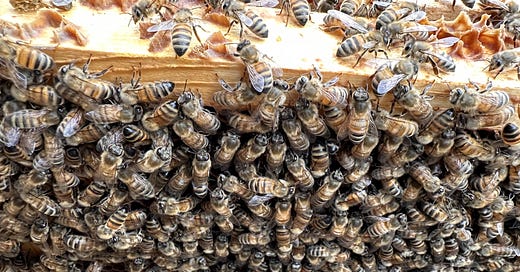🐝 This is Bee-Witched, notes from a beekeeper on making art to live life.🐝
“Years ago a wizened old beekeeper told me that keeping bees doesn’t take much time, but the things that must be done, must be done on time. That simple idea became my beekeeping mantra, and I believe that ethic, more than anything else, has helped me to be successful.” - For the best overwintering success, do one thing differently, from Rusty at Honey Bee Suite, aka the best beekeeping blog on the internet.
I arrived at the gate to look at my beehives, only to find them falling apart, paint chipped, parasites everywhere. One of the walls was collapsing in, and the other beehive had a huge gash where the entrance usually is, and the bees had all died of cold. I scooped their lifeless bodies up with my hands.
The season here is turning into autumn, and I’ve already had my first bee nightmare of the year. Hooray! The colder months are a fraught time in my subconscious world, apparently. But what exactly is going on here?
Why is a bit of cold such a big deal? Well, it’s not: but I didn’t always know that.
1 thing + 1 other thing = beehive nightmares
The BBKA Guide to Beekeeping advises over 14 degrees Celcius for a first quick inspection and over 17 degrees Celsius for your first full inspection. This is because the bees inside work even harder to maintain the ambient interior temperature of 35-ish degrees Celcius during the colder months. I guess the thinking goes that you’ll really harm them if you open up the hive. Unfortunately I took this as gospel.
However, the bees are in there, doing their winter survival act. So when you “can’t open the hive,” who knows what’s going on in there! The hive could be falling apart! They could be dead! It’s clear that months of wondering and waiting prove fertile ground for all kinds of catastrophising.
But I mean like, come on, right? Since when is anything set in stone?
I used to live on Twitter and thought this platform was one of the hard facts of my universe and yet here we are in the Year of our Lord 2024 and it’s called X and is now crap!
I’m not saying honey bees are like Twitter except sometimes they are, in the way that the longer I keep bees, the more I learn that things rarely go to plan, and you can never know everything.
Every action is on a hive-by-hive basis.
Everything depends on local conditions.
Everything depends on reacting to what’s really happening in the hive, instead of assuming you know what’s happening because you read a book about it.
Reminder: my shop is newly stocked with kitschy assemblage art in altered tins. They all have a ‘d’ hook on the reverse side, so that they can be hung flat against the wall. Like all of my work apart from the zines, these are completely one of a kind and will never be replicated.
Right now, for example, I’m dithering about treating them for varroa (as an extra precaution, it’s already been done), and feeding them sugar syrup. It’s gotten cold though. And windy. But…honestly, just like in my life, if I’m making excuses to not do something (it’s “too cold” or “too windy”), it probably really needs doing, and now.
Are you interested in the bee science? I mean it’s still good to geek out on it, even if you know you gotta do what you gotta do. Check out this post from the Apiarist. It talks about the winter bee ball, different temperatures’ effects on bees, and has a load of great diagrams. I quoted some cool stuff from it here in an earlier post from January this year:
🦋 Thanks for being here
See you next week! I always love to hear from you in a comment, with a ❤️, or even a restack to Substack Notes. 🐝




